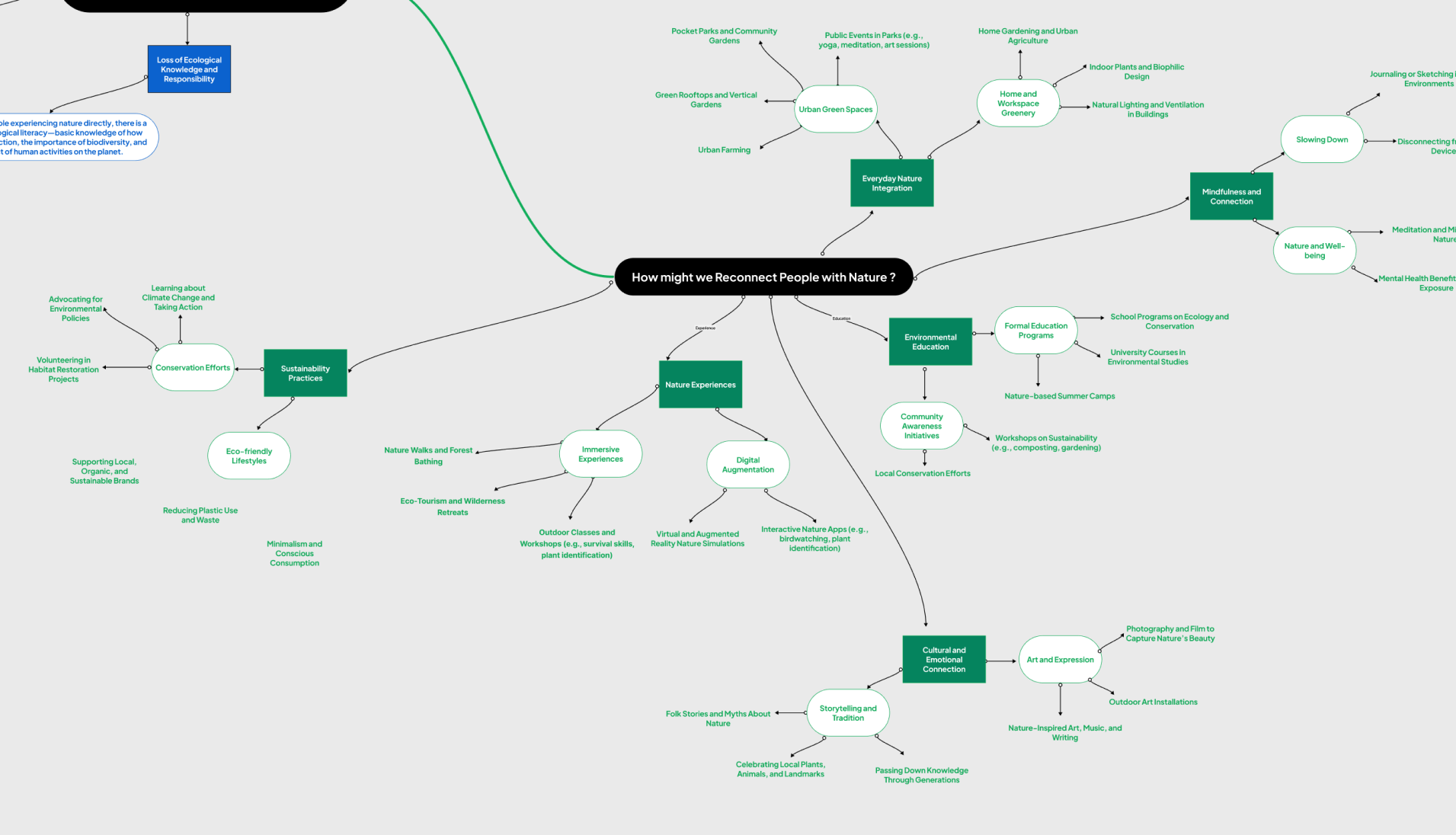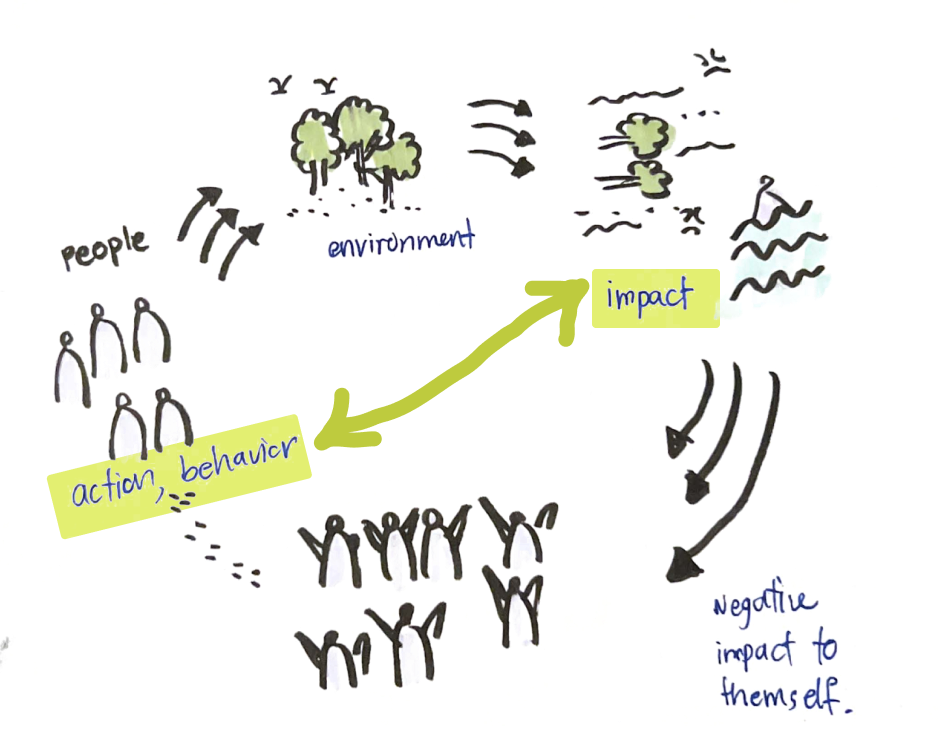Research Questions 1
What if we could change the future of environmental issues?
How might we raise awareness about environmental issues in a way that inspires people to take sustainable actions?
Research Questions 2
What if actionable guidance and immediate feedback could motivate people to adopt sustainable behaviors?
How might we communicate the impact of environmental problems in ways that resonate with people's personal well-being and responsibilities?
Mind mapping
I started mind mapping by focusing on the problem: what are the environmental issues, and what's happening? I identified key issues like air pollution, brownfields, plastic waste in the oceans, climate change, and global warming. These problems impact people’s physical and mental well-being, from heatwaves to deteriorating air quality.
After creating the first diagram, I realized that these issues result from human actions toward the environment. So, my next question was, why is this happening? I found that the root causes are human activities, such as overuse of plastic containers, neglect of environmental issues, land misuse, monoculture farming, deforestation, and lack of environmental knowledge.
As I mapped this out, I felt that all these problems stem from a disconnection from nature. This disconnect leads people to engage in harmful actions without fully understanding their impact.
With this insight, I created a mind map exploring ideas for how we might help people reconnect with nature.
Reflecting on this process, I found that mind mapping is valuable for uncovering root causes and understanding the connections, relationships, and cause-and-effect dynamics within complex issues.
"If people are made aware of the ‘how’ specific, actionable steps to address environmental issues, they will transition from awareness to adopting sustainable practices."
"If people are shown how environmental issues directly impact their daily lives and are provided with engaging, relatable experiences, then they will be more likely to take sustainable actions."
Storyboard
A disconnection of nature
What inspires me to take on this project is the realization that many people are unaware of the infinite loop they are part of
Their actions harm the environment.
These environmental issues circle back and negatively impact their own lives.
Data from online survey
45.9% strongly agree that individuals have a meaningful impact on solving environmental problems.
Combined with 32.4% moderately agreeing, this shows that 78.3% of respondents recognize their potential influence.
Insight: People believe they can make a difference, but they need guidance on how to take action.
Belief in Individual Impact
Barriers to Addressing Environmental Issues
The top barriers include: Lack of government policies (75.7%) ,Lack of individual motivation (64.9%), Limited public awareness (62.2%)
Insight: There is a need for education and policy-driven initiatives to create clear pathways for sustainable action. Motivating individuals through relatable content can overcome inertia.
Data from online survey
67.5% (40.5% + 27%) feel that disconnection from nature is a significant factor in environmental issues.
This highlights that many people feel removed from nature, which reduces their sense of responsibility or urgency to act.
Insight: Bridging this emotional and physical gap between people and nature could inspire greater action.
Disconnection from Nature
Actions People Are Willing to Take
Top sustainable actions include;Reduce, reuse, and recycle (91.7%),
Use eco-friendly products (75%),Educate others on environmental issues (72.2%)Insight: People are open to taking tangible, straightforward actions like recycling and adopting eco-friendly products. However, providing accessible knowledge and tools to help them educate others could amplify the overall impact.
Most concern Environmental issues
1.Focus on pollution : related content, emphasizing its direct impact on people’s lives (e.g., clean air initiatives, water safety).
2.Link climate change topics to tangible examples (e.g., heatwaves, natural disasters) to make it feel more immediate.
3.Highlight deforestation as an entry point to discuss larger environmental challenges, showcasing solutions like reforestation and sustainable land use.
Reconnection Experience
Everyday Nature Integration
Advocate for urban development projects ,Provide workshops and resources to help individuals create small green spaces at home or work.
Zero-Waste Membership
48.1% interest, this option highlights participants' desire for structured incentives to adopt sustainable habits.
Eco-Tourism Platform (Nature Tour Booking)
44.4% interest, Create an affordable and localized eco-tourism platform that emphasizes community-based activities. Include educational components to foster awareness during the tours

Affinity Map
I organized the notes from the 5 interviews, then categorized all the information to identify themes.
I combined both quantitative and qualitative data to derive actionable insights.
Overall insights

Findings
Stakeholders
Personas
Sophia Lee
The Conscious Young Adult
Goal
Learn and apply sustainable practices in her daily life.
Engage in projects and initiatives that align with her values, like reducing waste and supporting eco-friendly businesses.
Frustrations
Feels overwhelmed by the scale of environmental issues and unsure where to start.
Finds it challenging to influence friends and family who prioritize convenience over sustainability.
Mike Adams
The Disconnected Individual
Goal
Focus on personal and family priorities over environmental issues.
Minimize expenses on non-essential items.
Frustrations
Does not see a direct connection between his actions and environmental impact.
Feels overwhelmed by the effort required to adopt sustainable habits.
User Journey
Concept
A gateway that connects people's actions to environmental issues, fostering awareness and promoting sustainable behavior.
Web AR , 3D interactive web, Environment issues, Interaction design
Reference
Case studies
3D Interactive Website
An Immersive Trailer for Opera North’s production
What is missing?
What Is Missing? is a multi-sited memorial created by Maya Lin to raise awareness through science-based artworks about the present sixth mass extinction of species, connect this loss of species to habitat degradation and loss, and emphasize that by protecting and restoring habitat, we can both reduce carbon emissions and protect species.
Uncommon Knowledge: Practices and Protocols for Environmental Information
The databases that landscape architects rely on to design future-oriented infrastructure—the SHP files and CSVs that describe a site’s climate, plants, and soils, often involve inadvertently appeal to extractive forms of knowledge production and storage. What if we were to design information infrastructures, both physical and digital, that are premised on collective ownership as opposed to existing systems that privatize, accumulate, and collect? This thesis responds to the contemporary environmental information economy at the site of Google’s first hyperscale data center in water stressed The Dalles, Oregon. On the ban
Rewild our planet
Augmented Reality, Web AR
An Immersive AR Nature Experience, a multi-sensory experience that repairs the connection between human beings and the natural world, based on the Netflix original documentary series Our Planet. This mobile ARCore application uses cutting edge immersive technologies to build compassion for our fragile world. Each realistic 3D biome emphasises the beauty of the natural world, but also the role humans play in reversing the loss of nature.
WWF Deutschland : Native Wildlife AR
WWF is accompanying wild animals that were once extinct in Germany on their way back. To support this mission of one of the largest international non-governmental organziations for wilderness preservation, we at Demodern developed a WebAR application to raise awareness about the endangered animals.
Wild Immersion Experiment Nature
Travel Through Nature, Solve Riddles and Encounter Animals in Augmented Reality. Engage in educational experiences with Augmented Reality (AR)! This interactive activity encourages collaboration as players work together to solve riddles and uncover virtual animals. It’s an innovative approach to deepening understanding and appreciation for wildlife.
Bio Urbanism
Cities are the answer to the climate emergency.‘Biourbanism’ is a city planning , urban design model, and sustainable actions that increases prosperity by assisting mayors, city leaders and planners create healthier, more resilient cities.







































